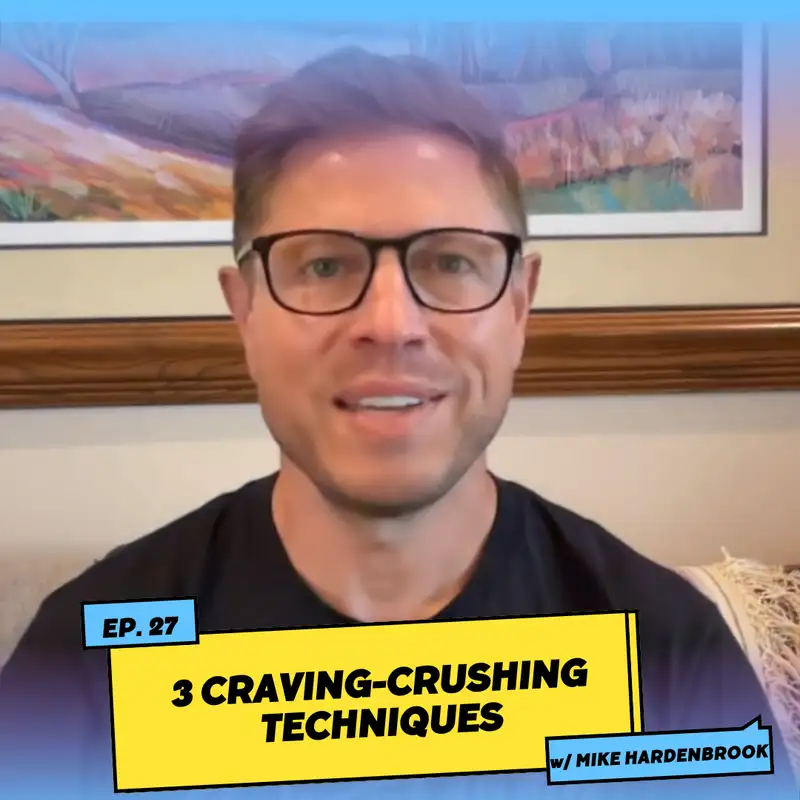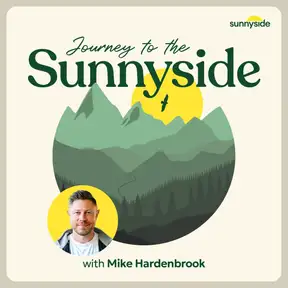10-Minute Mondays: 3 Craving-Crushing Techniques
Welcome to Journey to the Sunnyside, the podcast where we have thoughtful conversations to explore the science of habits, uncover the secrets to mindful living, and, of course, inspire your own mindful drinking journey. This podcast is brought to you by Sunnyside, the number one alcohol moderation platform. And if you could benefit from drinking a bit less, head on over to sunnyside.co to get a free 15 day trial. I'm your host, Mike Hardenbrook, published author, neuroscience enthusiast, and habit change expert. Okay.
Mike:Today, we're back doing another one of these 10 minute Mondays. If you're finding these useful, the best way you can support the podcast is by leaving a review on whatever platform you're listening to, or feel free, as always, send me an email, mike@sunnyside.co. I'd love to hear from you. And today, we're going to talk about one of the most important and challenging things when it comes to changing our habits, and that is dealing with cravings. And cravings are difficult because they can make you feel overwhelmed.
Mike:You can make you feel on the brink of breaking your commitment. But the research shows fortunately that cravings only last usually between 15:30 minutes. Although when you're going through those cravings, it can feel much longer. And let me cite a study by the Psychology of Addictive Behaviors that found on average cravings only last about 20 minutes. So I'm gonna talk in this 10 minute episode about some things that we can actually do at any place to help get us past those cravings.
Mike:So let's talk real quick about what cravings are doing. And this is basically the brain's way of signaling that it wants something familiar. It wants something that has a reward attached to it. And it's really related to dopamine release, which dopamine is a neurotransmitter that's associated with pleasure and reward. So if we consistently give into this, the brain reinforces this behavior, and it creates this habit loop.
Mike:And that's why it's difficult for us to break it. And that's why it's important for us to get past the cravings so that we can change our behaviors and habits long term. So today, I'm gonna share 3 techniques. And the techniques I'm gonna share today are ones that you can do almost anywhere at any time to help you get past these cravings. And while there are many other techniques that you can use, some of them will require you to either have a gym.
Mike:Let's say if it's gonna be exercise, maybe it's gonna be breath work or meditation. So you need a dedicated space and quiet. And while those are all great and you should research and look into those, I'm gonna pass on 3 that you could do at any time. Let's say you're in a busy restaurant. Let's say you were at work or you're just sitting at home alone, wherever it is.
Mike:These are techniques that you can use pretty much anywhere, anytime. And before I get into that, one thing I want to talk to you about cravings is this mental resistance that we build up. Part of the resistance is, I can't do this. I can't do this. And so I wanna talk to you real quick with a clip from Nir Eyal, who I did the master class on mindful drinking with, and so I'm gonna play that real quick.
Nir:Or the case might be. I can give into that distraction, but not right now. Because what we find is for many people, abstinence can backfire and it backfires because of the psychological phenomenon called reactant. Reactants is when we are told what to do, when our agency is threatened, when our control and autonomy comes under threat, we rebel. Now here's the crazy thing.
Nir:The brain will elicit psychological reactants. The relief of no longer having to tell myself no feels good, and the brain registers that as a reward and keeps us doing it again and again and again. So instead of telling yourself no, you're gonna tell yourself not yet.
Mike:So So Nir brings up a really crucial point, and that is our brains are wired to resist when we impose strict limitations on ourselves. So by reframing our thoughts to not right now, we give ourselves that psychological space to manage those cravings without feeling so deprived. So let's jump into the 3 effective techniques to manage or overcome our cravings. So technique number 1 is go for a walk. And this seems like one of those obvious, Yeah, I've heard that before.
Mike:But are you actually putting this into a strategy when you get those cravings? And a lot of times it's not. And the reason I say that is this is the simplest but also one of the most effective strategies. So sometimes the simplest get overlooked because it couldn't be that easy. But here's the reason why it works.
Mike:Number 1, it's distraction. It provides physical distraction. If you're going for a walk, you're putting on your shoes, you're going out, you're looking around, you're not only focused on that craving that eventually might break if you're not doing anything but thinking about it. Number 2 is it releases endorphins. So physical activity releases that endorphins.
Mike:That's that feel good, chemical that also reduces your stress. So number 3 is environmental change. So it's going to get you out of wherever you are. If you're sitting in your living room, you're going to have a change of scenery. It's going to help you break that mental loop in that craving, and it's just gonna provide you with a new outlook.
Mike:And there are studies that support this. So let me cite one, which is published by the journal of appetite, which found that even a short 15 minute walk can significantly reduce chocolate cravings among those participants. So even though we're talking about chocolate, chocolate has sugar, sugar is addicting, and it's the same sort of thing. People have just as hard time of resisting those cravings as they do with what we're talking about here. And this is one that I highly recommend and is pretty much anyone can do it anytime, anywhere.
Mike:Alright. Technique number 2 is EFT tapping, which stands for emotional freedom technique. And this is all about tapping different meridian points on your body while focusing on cravings and expressing your affirmations. And I know for some of you, this might be too far out there. But I have to tell you I had the same sort of resistance at first, but I can also tell you it absolutely works for me.
Mike:And if it works for me, I'm sure it could work for you and it's worth a try. So before I give you a real quick walk through on how that works, let's tell you why it works. And that is number 1, stress reduction. So EFT can lower cortisol levels, which then lowers stress, anxiety, and helps you get past those cravings. The other is that it interrupts the cravings cycle.
Mike:So tapping interrupts that cycle, which helps rewire the brain's response to those cravings. So I'm gonna give you a quick rundown. I urge you if this is interesting to you to go look on YouTube and find some more in-depth on how to do this. But I just want to give you an idea on how it works. Okay.
Mike:So let's go through the basic techniques for doing this. So number 1, acknowledge your craving. Rate it from a 1 to 10 how you're feeling. You know, are you an 8 and you're really just on the edge here? And then we wanna do a setup statement.
Mike:So the first thing we wanna do is start tapping on the karate chop point of your hand. It can be, I just I accept myself, but acknowledge the craving. Or it could be like, even though I really want to reach for that beer. I accept myself. So whatever feels right to you.
Mike:And we're going to start with the karate chop here. You need to do it like 5 to 7 times, and then you're gonna move to the bone above your eye. Follow that bone to the outside and keep tapping, and you'll just say, this craving for alcohol. And then below the eye, this craving for alcohol. And then below the nose, above the lip, there's craving for alcohol.
Mike:And then between the chin and the lip, there's craving for alcohol. And then below the collarbone here, about an inch, there's craving for alcohol. And it could be that beer I want. And then below the armpit, about 3 inches, is craving for alcohol. And then at the top of the head, is craving for alcohol.
Mike:And then check-in with yourself and see how you feel, you know, and then rate yourself. Are you from an 8 to a 6? Or maybe you're still at an 8. If you are, go ahead and repeat it. And I guarantee that you're gonna get some results.
Mike:Again, there are more in-depth resources for this if you go and search for them. And then technique number 3, our final one is urge surfing. Urge surfing works. I just have to say that real quick. So what this really involves is observing our cravings without actually acting on them.
Mike:And the reason that they call it urge surfing is because we kind of ride the wave of this craving without feeling overwhelmed by it. We acknowledge it. And so why does it work? So number 1 is mindfulness. It increases our awareness and acceptance of these cravings without judging ourselves by being a passive observer.
Mike:And then number 2 is non resistant. So it reduces the power of the cravings without fighting against it. We just look at it, we observe it, and we let it pass. So how do you do urge surfing? Let's get into the basics of those techniques.
Mike:The first thing is you want to find some place quiet where you can just either stand or sit and close your eyes. And the first thing you do is acknowledge the craving. So notice that the craving is there and take a mental note of its presence. Then number 2 is observe the sensation. So focus where you're feeling this craving.
Mike:Is it in your body? Think about it. Describe it in detail. What's its intensity? And then number 3 is ride the wave.
Mike:So you want to picture this craving as a wave. Is it rising in intensity? Is it going way up fast? Is it going a slow build? Whatever it is, allow it to envision in your mind and see it for what it is.
Mike:And you're letting it rise and then eventually it's gonna get to as high as it can get, and you're not gonna act on anything. You're just gonna let it go there. And it might stay there for a little while or might subside really quick, but you don't want to act on it. That's the point of this is that you just acknowledge the craving, let it build to its intensity that it's gonna get to. And eventually, we already know that these cravings pass in 15 to 30 minutes.
Mike:So it might pass in that 5 minutes, that 2 minutes that you're doing it and allow it to subside and go down and ride it out, ride the wave. K. So those are the 3 techniques to get past cravings. And remember changing your habits around alcohol, this is a big journey that you're taking on. I commend you for doing it.
Mike:But the fortunate thing is that we already talked about cravings are temporary, and you have the power, especially with techniques like this, to overcome them. And big part of that is understanding the science behind these cravings, why it's happening, how we can break that habit loop and form new and healthier habits that align to our goals. Again, if you found this helpful, please leave us a review on whatever podcast platform you're listening to, and send me feedback to mike@sunnyside.co. Thanks a lot. This podcast is brought to you by Sunnyside, the number one alcohol moderation platform, having helped 100 of thousands of people cut out more than 13,000,000 drinks since 2020.
Mike:And in fact, an independent study showed that Sunnyside reduced alcohol consumption by an average of 30% in 90 days. And as one of our members shared, Sunnyside helps me stay mindful of my drinking habits. It's not super restrictive. So if I'm craving a glass of wine with dinner, I just track it and I move on with my week. If you could benefit from drinking a bit less and being more mindful of when and how much you drink, head on over to sunnyside.co to get a free 15 day trial.
Mike:You'll get access to everything that we offer, including tracking and planning tools, coaching from our experts, a vibrant community of people just like you, and the motivation and advice to stay on track with your health goals, all with no pressure to quit. That's sunnyside.co.
Creators and Guests


